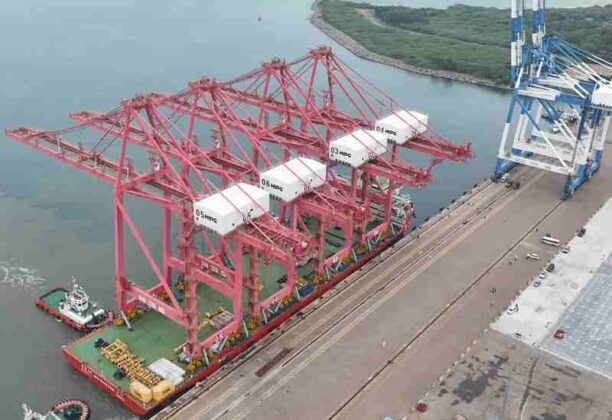
Vessel with Quay Cranes arrives at Hambantota Port
Set to be fully operational by January 2025, the enhancement of the Sri Lankan port involves the deployment of four Quay Cranes (QCs) and 13 Rubber-Tyred Gantry Cranes (RTGs), which will elevate its annual container handling capacity to 1 million TEUs.
The Quay Cranes, transported by the vessel De Qiang 66 and arriving on November 30, come with a 65-meter outreach for Twinlift operations and have notable lifting capacities: they can handle 50 tons individually, 65 tons in tandem, and 75 tons using the underhook beam.
These cranes also provide a lifting height of 42 meters above the rail and 20 meters below it. Concurrently, the RTGs, which arrived via the Feng Hai Da vessel on the same date, feature a 23.47-meter span, a base distance of 6.9 meters, a lifting configuration of 1-over-5, and a single lift capacity of 41 tons. In line with green port initiatives, these new cranes are fitted with sophisticated automation systems and anti-collision technology, guaranteeing safe and efficient handling operations.
“Our investment in these new cranes will considerably enhance HIP’s container handling capabilities, positioning us as a fully-fledged multipurpose port for Sri Lanka,” stated Wilson Qu, CEO of HIPG.
The new equipment supplements HIP’s current fleet, which consists of two Quay Cranes, three Rubber-Tyred Gantry Cranes, four Reach Stackers, and three Empty Stackers. The upcoming cranes are anticipated to be put into service within a two-month timeframe, representing a key phase in HIP’s growth strategy.
Qu added: “This capacity building is crucial for our transshipment operations and will attract potential investors looking to establish manufacturing plants in our industrial zone. We already have several inquiries in regard to the setting up of manufacturing plants in the port’s industrial zone. In addition to that, our marketing team is committed to promoting these developments globally to engage the right partners for our initiatives.”
The CEO of HIPG highlighted that the imminent feeder services connecting Hambantota with Sri Lanka’s other key port, Colombo, will reinforce the domestic maritime shipping network. Merging HIP’s increased capabilities with the country’s broader infrastructure is poised to enhance the efficiency of cargo transportation, aiding the national objective of processing 10 million TEUs in the 2025–2026 timeframe.

